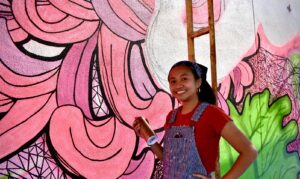Annie Dong’s work has been erased twice. She talks about censorship and community.
By Dania Hefley
Original Air Date: November 26, 2025
Host: It’s been two months since the state government forced Florida cities, including Sarasota and Bradenton, to erase street art. WSLR News reporter Dania Hefley is gauging how this has impacted the public art scene. Part One puts the focus on a local painter whose murals were erased not just once but twice.
Dania Hefley: In a recent interview, Sarasota artist Annie Dong, currently pursuing post-graduate studies in Michigan, spoke about the challenges surrounding art, censorship and community murals in Florida. Dong, known for her vibrant public works, shared her experiences with having one piece removed two years ago by her alma mater and another one in Sarasota’s Burns Court neighborhood.
In September, City of Sarasota workers sandblasted her sidewalk art and that of dozens of other painters celebrating the county centennial. They did so after the city was threatened by state that it would withhold funding for roads and transportation. Dong offered her perspective on the current climate for artists.

Annie Dong. Photo: K. Murray
Annie Dong: It only really has been just the New College of Florida mural that I did when I was a sophomore at Caples that was removed, and then just the Chalk Festival one. I had a couple of them removed.
DH: Dong pointed directly at politics.
AD: I believe they are all—for sure, there’s a common theme that’s happening in Florida with the politics—specifically of Florida. People in power in Florida don’t really like colorful art that spreads positivity unless it has to do with their own beliefs.
DH: The artist censorship played a significant role in her decision to pursue her education outside the state, where she is focusing on expanding her work into different arenas.
AD: I left Florida to chase more opportunities to grow as an artist and me to get out of the context of Florida because of its censorship. I’m more focused on enhancing and exploring my art practice and really get in the realm of more gallery work—more museum work.
DH: Despite the move, she maintains strong ties to the region and continues to work here.
AD: I’m mainly based out of Florida still for doing my murals and contracting with cities. They fly me out in different cities in Florida to paint murals there still.

Annie Dong and her – now erased – Red Crowned Cranes mural. Photos via anniedartist.com
DH: During the summer after her sophomore year at New College, one of Dong’s murals on campus was quietly painted over. The administration later tried to make amends, offering her a new wall in the Hamilton Center Cafeteria—now home to her bright fruit basket mural in her signature style.
After her first experience with erasure at New College, Dong began to adapt. She had been creating murals on transportable panels, a direct response to the risk of destruction. Speaking about a community mural project done in Bradenton, she explained the practical and symbolic purpose of this method:
AD: I built the panels—even my undergraduate like thesis, I built two complete different pieces, and they’re all on panels because of the fear of getting it destroyed again. I can just literally take it and go. In a way, where it’s on panels, it can be transported, installed in many different locations. It’s a rotating piece of art that can be installed with the proper wall and the proper space and spread more joy across different areas.
DH: She emphasized the importance of public art, particularly for marginalized youth.
 AD: It’s crazy because beneficial projects like these and public art are so important to the community, yet it’s getting erased. I don’t understand that part.
AD: It’s crazy because beneficial projects like these and public art are so important to the community, yet it’s getting erased. I don’t understand that part.
DH: Dong described the muralist community in Florida as small but tight-knit. Amid the difficulties, that sense of community has become even more important.
AD: The mural and artist world in Florida is an incredibly small community. We really uplift each other. I think that’s really awesome and inspiring. The artist community is just great in Florida. Unfortunately, it’s a hot pocket where it’s not so welcomed.

The City of Sarasota in September sandblasted dozens of sidewalk paintings in the Burns Court neighborhood that celebrated Sarasota’s centennial. “Indian Paintbrush” by Cathy Gallatin, recreation of an oil painting by Thomas Blackshear. Photo: J Werner
DH: She acknowledged that destruction is an inherent risk of public art.
AD: Unfortunately, this is more of a censorship kind-of happening with it.
DH: Despite the past issues with erasure, Dong remains open to contributing to the city’s public artscape. She confirmed a new commission may be in the works.
AD: It is an opportunity, and I hope I secure it because it sounds really fun.
DH: Reporting for WSLR News, Dania Hefley.
WSLR News aims to keep the local community informed with our 1/2 hour local news show, quarterly newspaper and social media feeds. The local news broadcast airs on Wednesdays and Fridays at 6pm.